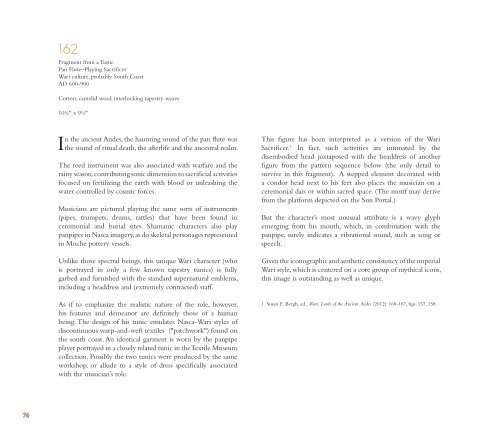You also want an ePaper? Increase the reach of your titles
YUMPU automatically turns print PDFs into web optimized ePapers that Google loves.
162<br />
Fragment from a Tunic<br />
Pan Flute–Playing Sacrificer<br />
Wari culture, probably South Coast<br />
AD 600-900<br />
Cotton, camelid wool; interlocking tapestry weave<br />
10½" x 9½"<br />
In <strong>the</strong> ancient <strong>Andes</strong>, <strong>the</strong> haunting sound of <strong>the</strong> pan flute was<br />
<strong>the</strong> sound of ritual death, <strong>the</strong> afterlife and <strong>the</strong> ancestral realm.<br />
The reed instrument was also associated with warfare and <strong>the</strong><br />
rainy season, contributing sonic dimension to sacrificial activities<br />
focused on fertilizing <strong>the</strong> earth with blood or unleashing <strong>the</strong><br />
water controlled by cosmic forces.<br />
Musicians are pictured playing <strong>the</strong> same sorts of instruments<br />
(pipes, trumpets, drums, rattles) that have been found in<br />
ceremonial and burial sites. Shamanic characters also play<br />
panpipes in Nasca imagery, as do skeletal personages represented<br />
in Moche pottery vessels.<br />
Unlike those spectral beings, this unique Wari character (who<br />
is portrayed in only a few known tapestry tunics) is fully<br />
garbed and furnished with <strong>the</strong> standard supernatural emblems,<br />
including a headdress and (extremely contracted) staff.<br />
As if to emphasize <strong>the</strong> realistic nature of <strong>the</strong> role, however,<br />
his features and demeanor are definitely those of a human<br />
being. The design of his tunic emulates Nasca-Wari styles of<br />
discontinuous warp-and-weft textiles ("patchwork") found on<br />
<strong>the</strong> south coast. An identical garment is worn by <strong>the</strong> panpipe<br />
player portrayed in a closely related tunic in <strong>the</strong> Textile Museum<br />
collection. Possibly <strong>the</strong> two tunics were produced by <strong>the</strong> same<br />
workshop, or allude to a style of dress specifically associated<br />
with <strong>the</strong> musician’s role.<br />
This figure has been interpreted as a version of <strong>the</strong> Wari<br />
Sacrificer. 1 In fact, such activities are intimated by <strong>the</strong><br />
disembodied head juxtaposed with <strong>the</strong> headdress of ano<strong>the</strong>r<br />
figure from <strong>the</strong> pattern sequence below (<strong>the</strong> only detail to<br />
survive in this fragment). A stepped element decorated with<br />
a condor head next to his feet also places <strong>the</strong> musician on a<br />
ceremonial dais or within sacred space. (The motif may derive<br />
from <strong>the</strong> platform depicted on <strong>the</strong> Sun Portal.)<br />
But <strong>the</strong> character’s most unusual attribute is a wavy glyph<br />
emerging from his mouth, which, in combination with <strong>the</strong><br />
panpipe, surely indicates a vibrational sound, such as song or<br />
speech.<br />
Given <strong>the</strong> iconographic and aes<strong>the</strong>tic consistency of <strong>the</strong> imperial<br />
Wari style, which is centered on a core group of mythical icons,<br />
this image is outstanding as well as unique.<br />
1 Susan E. Bergh, ed., Wari. Lords of <strong>the</strong> <strong>Ancient</strong> <strong>Andes</strong> (2012): 168-167, figs. 157, 158.<br />
76







